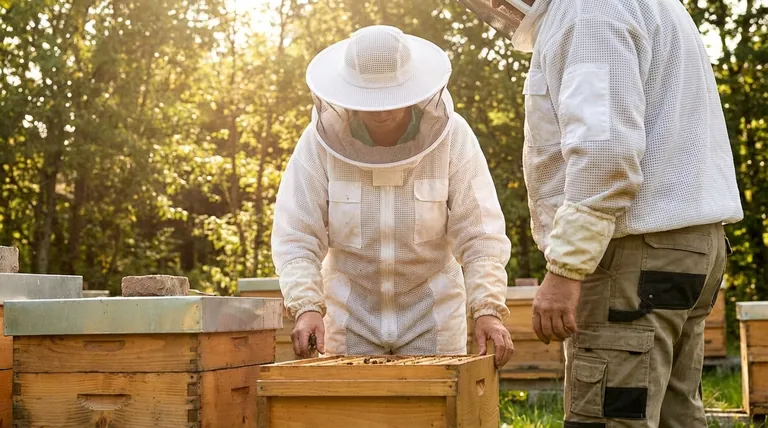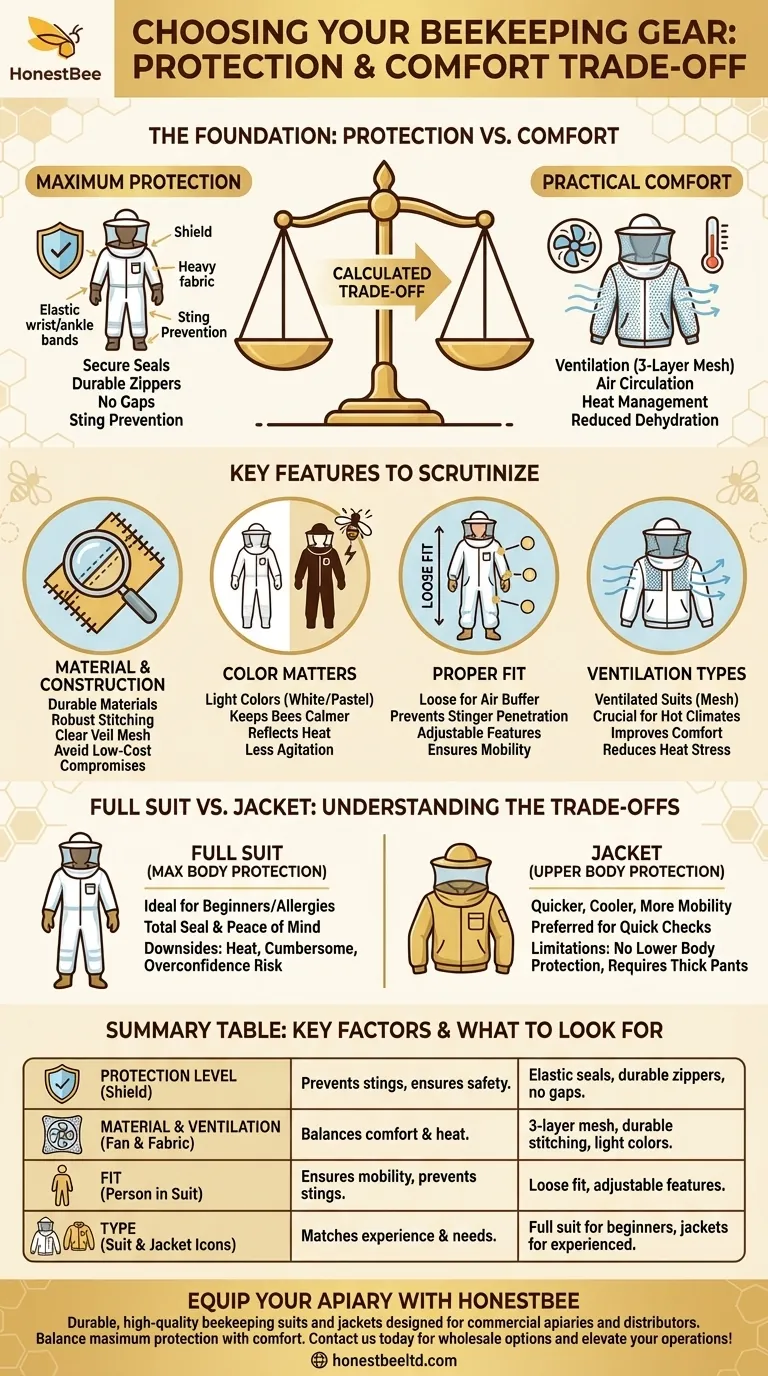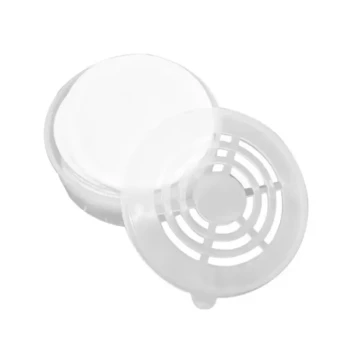When selecting a beekeeping suit or jacket, the most critical factors to evaluate are the level of protection, the material and its ventilation, the overall quality of construction, and the fit. These elements work together to ensure your safety from stings while providing the comfort necessary to work effectively with your hives.
Your choice is not about finding one "best" suit, but about making a calculated trade-off. The ideal gear balances the absolute security you need with the practical comfort your climate and work style demand.

The Foundation: Protection vs. Comfort
The core decision in choosing a bee suit revolves around a fundamental tension: the need for impenetrable protection versus the need for physical comfort, especially regarding heat.
Prioritizing Security Against Stings
A suit's primary job is to prevent bees from reaching your skin. Look for elastic bands at the wrists and ankles, which create a secure seal.
High-quality, durable zippers that are easy to use with gloves are also essential. The design should ensure there are no gaps where a determined bee could enter.
The Critical Role of Ventilation
Working in a full suit, especially in summer, can quickly lead to overheating and dehydration. This isn't just uncomfortable—it's a safety risk that can impair your judgment.
Ventilated suits, often made of a 3-layer mesh, are the modern solution. They allow air to circulate freely while keeping the bees' stingers from reaching your skin. While more expensive, they dramatically improve comfort during long inspections in warm weather.
Deconstructing the Suit: Key Features to Scrutinize
Beyond the basic type, the details of a suit's construction determine its effectiveness and longevity.
Material and Construction Quality
A well-made suit uses durable materials and robust stitching. Pay special attention to the mesh on the veil, which should offer clear visibility without being fragile.
Be cautious of extremely low-priced suits (e.g., under $100). While tempting, they often compromise on material quality, zipper durability, and stitching, which can lead to failures at critical moments.
The Importance of Color
Bees are known to react with more agitation to dark colors, which they may perceive as a natural predator.
For this reason, beekeeping suits are almost always white or a light pastel color. This helps keep the bees calmer and also has the added benefit of keeping you cooler in the sun.
Achieving the Proper Fit
Your suit should fit loosely, creating a buffer of air between the fabric and your skin. A suit that is too tight can stretch the material, making it easier for a bee's stinger to penetrate.
Look for adjustable features like drawstrings or elastic waistbands to customize the fit. A good fit is not just about protection; it also ensures you can move and work without feeling restricted.
Understanding the Trade-offs: Full Suit vs. Jacket
Your experience level and beekeeping goals will influence whether a full suit or a jacket is more appropriate.
The Case for a Full Suit
A full, one-piece suit offers maximum body protection. This is the ideal choice for new beekeepers who may be nervous or for anyone with a known or suspected bee allergy. It provides peace of mind by completely sealing you off.
The Downsides of a Full Suit
The primary drawback is heat, especially in non-ventilated models. They are also more cumbersome to put on and take off. Some argue that the total protection can lead to a sense of overconfidence, causing beekeepers to be less careful in their movements around the hive.
The Practicality of a Jacket
A beekeeping jacket offers protection for the entire upper body and head. It is quicker to put on, cooler than a full suit, and offers more freedom of movement. Many experienced beekeepers prefer jackets for quick hive checks.
The Limitations of a Jacket
The obvious limitation is the lack of lower-body protection. You must pair a jacket with thick, light-colored pants (like heavy-duty work pants or jeans) and ensure there is no gap at your waist where bees could enter.
Making the Right Choice for Your Goal
Select your gear based on a clear assessment of your priorities.
- If your primary focus is maximum safety as a new beekeeper: Choose a high-quality, full-body ventilated suit for complete protection and comfort.
- If your primary focus is convenience for frequent work in a hot climate: A premium ventilated jacket paired with thick, appropriate pants offers the best balance of safety and comfort.
- If your primary focus is managing a strict budget: Invest in a well-constructed, non-ventilated full suit from a reputable brand and plan to work during cooler parts of the day.
Ultimately, your protective gear is an investment in your ability to be a calm, focused, and effective beekeeper.
Summary Table:
| Key Factor | Why It Matters | What to Look For |
|---|---|---|
| Protection Level | Prevents stings and ensures safety. | Elastic wrist/ankle seals, durable zippers, no gaps. |
| Material & Ventilation | Balances comfort and heat management. | 3-layer mesh for airflow, durable stitching, light colors. |
| Fit | Ensures mobility and prevents stings. | Loose fit, adjustable features (e.g., drawstrings). |
| Type (Suit vs. Jacket) | Matches your experience and needs. | Full suit for beginners/jackets for experienced beekeepers. |
Ready to equip your apiary with the right protective gear? At HONESTBEE, we supply durable, high-quality beekeeping suits and jackets designed for commercial apiaries and distributors. Our products are built to balance maximum protection with comfort, ensuring your team stays safe and productive. Contact us today to discuss wholesale options and elevate your beekeeping operations!
Visual Guide

Related Products
- Cotton Folding Square Beekeeping Hat and Veil with Removable Mesh Bee-Proof Design
- Wholesales Dadant Size Wooden Bee Hives for Beekeeping
- Yellow Plastic Bucket Pail Perch for Beekeeping
- Professional Insulated Plastic Bee Hives
- Long Langstroth Style Horizontal Top Bar Hive for Wholesale
People Also Ask
- What types of head protection are available for beekeepers? Choose the Right Veil for Safety & Confidence
- What is the difference between a beekeeping suit and a jacket? Choose the Right Protection for Your Apiary
- What should you do if you find an ant nest near your beehive? Essential Strategies for Hive Protection
- Which type of bee veil offers the best protection? Maximize Safety with Proper Space and Design
- What is the function of a beekeeper hat and veil? Essential Head & Face Protection for Beekeepers



















